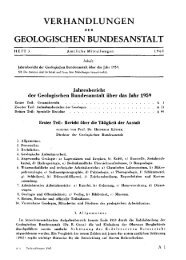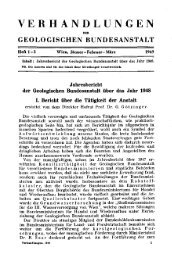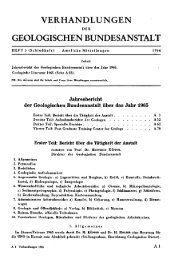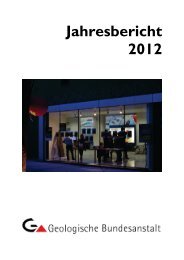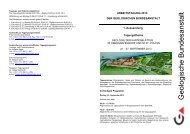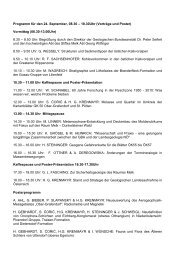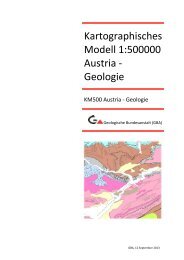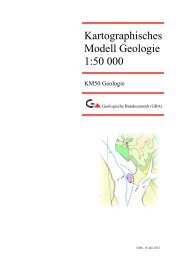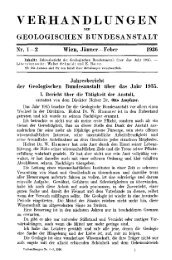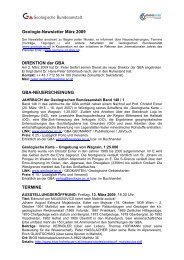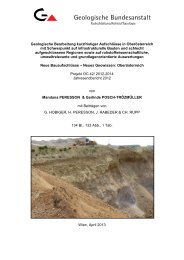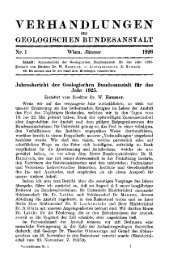Field Trip B TRIASSIC CONODONT LOCALITIES OF THE ...
Field Trip B TRIASSIC CONODONT LOCALITIES OF THE ...
Field Trip B TRIASSIC CONODONT LOCALITIES OF THE ...
You also want an ePaper? Increase the reach of your titles
YUMPU automatically turns print PDFs into web optimized ePapers that Google loves.
thology as well as by the main Choristoceras marshi-layer.<br />
The Koessen Beds are widely distributed in the northern part of the Calcareous Alps forming a sequence<br />
of thin to medium bedded dark limestones alternating with black to greenish marls and siltstones<br />
with a total thickness of 200 to 300 m. They contain a rich megafauna mainly composed of bivalves<br />
and brachiopods the latter being recently revised by PEARSON 1977. Stratigraphically the Koessen<br />
Beds occupy a position between the Norian Hauptdolomit and various Liassic sediments (e. g., Adnet<br />
Limestone, Lias Fleckenmergel), thus ending at the top of the Triassic. By the pioneer study of<br />
SUESS & MOJSISOVICS 1868 four main facies have been recognized in the Osterhorn syncline near<br />
St. Wolfgang. In ascending order they are:<br />
1) Swabian facies, predominantly composed of thin layered shell beds containing shallow water bivalves<br />
such as Rhaetavicula, Gervilleia and Modiolus.<br />
2) Karpathian facies, mostly nodular limestones and marls with a mixed bivalve and brachiopod fauna<br />
the latter dominated by the genus Rhaetina.<br />
3) Koessen facies, forming a sequence of well bedded micritic limestones» (locally with cherts) and marl<br />
intercalations. The fauna is composed of brachiopods dominated by the genus Oxycolpella (an unusual<br />
large spiriferid), ammonites (abundant Choristoceras, Eopsiloceras) and rare bivalves.<br />
4) Salzburg facies, composed of dark soft shales containing pyritized ammonites restricted to the genus<br />
Choristoceras (stratum typicum of Choristoceras marshi).<br />
Based on the study of the famous section Weißloferbach (stratotype of Koessen Beds) URLICHS<br />
1973 presented arguments to consider the Salzburg facies only as a thick marls intercalation of the<br />
Koessen facies, a procedure followed by the author. Concerning thickness the Koessen facies corresponds<br />
to the upper third of the total Koessen Beds. Only this part contains an abundant pelagic fauna<br />
composed of ammonoids and conodonts indicating a deeper environment of approximately 100 m<br />
(OHLEN 1959); benthonic organisms are less frequent, in particular bivalves (no Rhaetavicula).<br />
At Gaissau section some 100 m of Koessen Beds are exposed the lower 30 m being mainly composed<br />
of black shales with nodular limestone intercalations (= Swabian + Karpathian facies). This basal<br />
part is succeeded by a 12 m thick layer of massive corallinacean limestone (Thecosmilia Lst.) which<br />
also occurs at section Kendlbachgraben. The upper part of the section (fig. 16) — corresponding to<br />
the Koessen facies — is represented by well bedded grey, partly marly limestones with two dark marls<br />
intercalations of which the lower one contains Choristoceras marshi. Compared with section Kendlbach<br />
some 10 to 20 m of the uppermost Koessen Beds are missing and hence, the Rhaetian/Liassie<br />
boundary is not exposed.<br />
Conodont research<br />
Conodonts from the Rhaetian Koessen Beds were first described by MOSHER 1968. Later on KO-<br />
ZUR 1971 and KOZUR & MOSTLER 1973 questioned these founds but changed their mind by subsequent<br />
studies (KOZUR & MOCK 1974 b). Finally, MOSTLER (in MOSTLER et al. 1978) published<br />
a large and distinct conodont fauna from the above mentioned section Weißloferbach. He attributed<br />
the fauna to two zones which were named in ascending order the rhaetica and posthernsteini-Zones.<br />
Almost all species described are represented in the Gaissau section too.<br />
The Gaissau section was studied in detail by EXARCHOS 1977 (unpubl. phil. thesis, Innsbruck<br />
University; forewarded to the author by the courtesy of H. MOSTLER). According to EXARCHOS<br />
M. hernsteini is restricted to the lowermost few meters of the sequence; M. rhaetica ranges a little<br />
higher up; and M. posthemsteini together with rare ramiform elements characterizes the upper part<br />
of the section thus confirming the zonation established by MOSTLER at Weißloferbach.<br />
Two samples collected by the author from the base of the Koessen facies yielded a rich fauna<br />
which is dominated by species of the conodont genus Misikella:<br />
G 1: Misikella hernsteini (15 x), M. rhaetica (5 x),M. posthemsteini (3 x), Neohindeodella triassica<br />
(lx).<br />
G 4: Misikella hernsteini (1 x), Misikella rhaetica (2 x),Neohindeodella triassica (1 x).<br />
At section Kendlbach (fig. 16) the uppermost conodonts occur 7 m below the base of the Liassic<br />
series. Sample K 790 contains M. posthemsteini and Hindeodella suevica. The argillaceous limestones<br />
(in part sandy 1st.) immediately underlying the Planorbis beds and conventionally placed within<br />
the topmost Triassic yielded no conodonts.<br />
95



